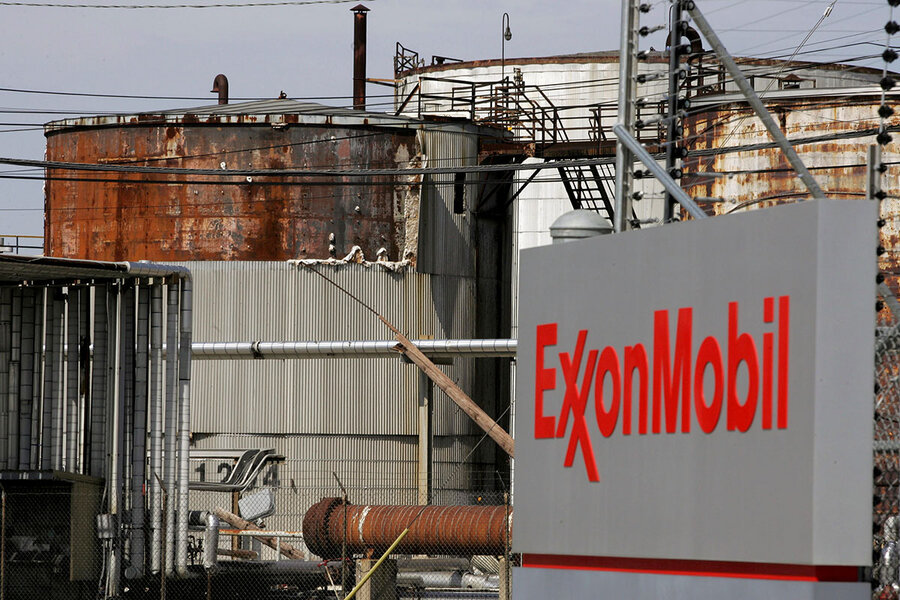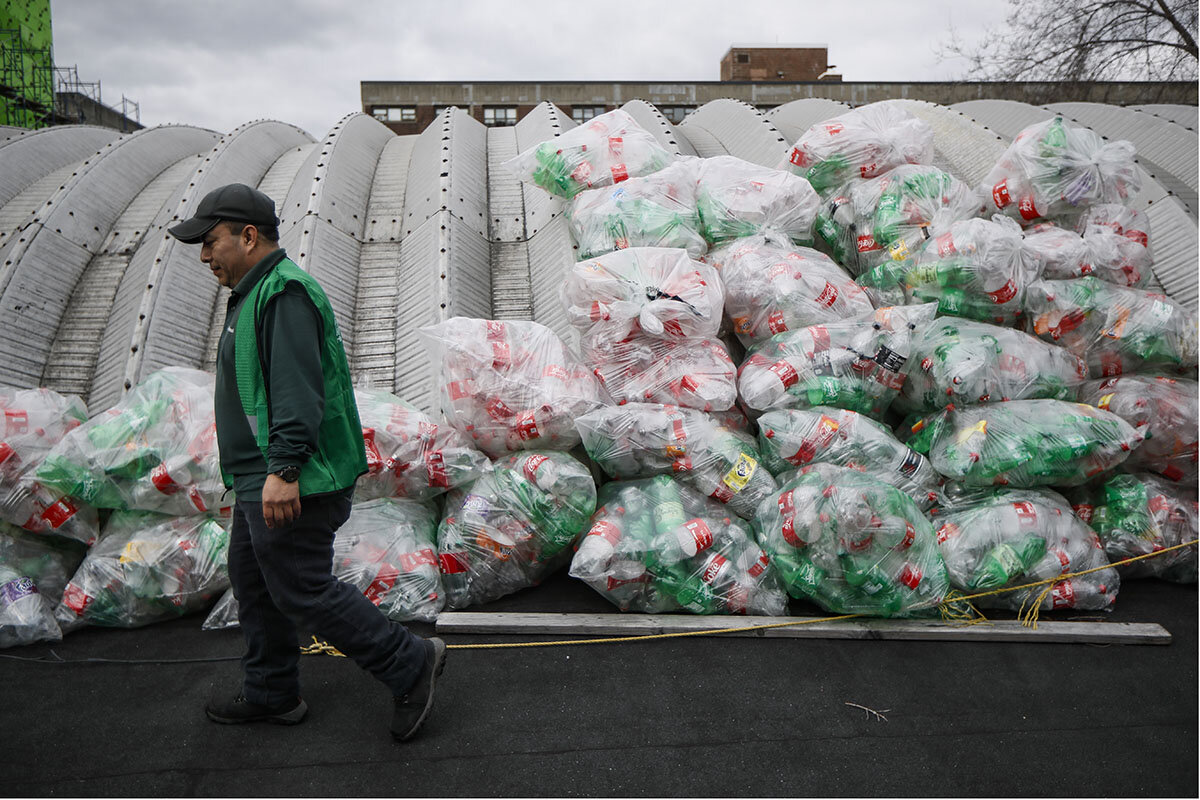Plastic as fuel? Why ‘advanced’ recycling gets mixed reviews.
Loading...
| Baytown, Texas
Baytown, Texas, is a city that stands in the shadow of the nation’s oil and gas industry. Located only 26 miles from Houston, it’s been home to an arm of the Gulf Coast petroleum corridor for more than a century. Look to the western horizon from Baytown’s east side in the evening and you’ll see a smear of orange, red, and yellow pastels blending into the Texas sunset, as it slips away behind the nation’s largest petroleum refinery.
The city is also among the key sites for the oil and gas industry’s next significant pivot.
ExxonMobil has already broken ground on an operational “advanced recycling” facility that it hopes to open next year. The operation is expected to be among the continent’s largest, with a capacity to recycle up to 30,000 metric tons of plastic waste annually. And it’s part of a petrochemical industry trend with global scope. ExxonMobil is building a similar facility in Notre Dame de Gravenchon, France, for example.
Why We Wrote This
“Advanced recycling” is an industry label for turning old plastics into new uses. But the bigger need – from both waste and emissions standpoints – may be to reduce single-use plastics in the first place.
The idea is to expand heat-intensive recycling methods for materials that aren’t amenable to more traditional recycling.
This may sound like a win for the environment – a way to responsibly handle waste at a time when China is doing less of the world’s recycling than it used to. The industry’s expansion, however, is being met with skepticism by many recycling experts, who cite a lack of evidence demonstrating advanced recycling’s effectiveness.
“This a way for the petrochemical industry to sort of signal that they’re responding and being responsive to some of these concerns that the public is raising” about the plastics crisis, says Sarah Morath, an associate professor of environmental law and food law at Wake Forest University and the author of the forthcoming book, “Our Plastic Problem and How to Solve It.”
Yet she and other experts say advanced recycling is far from a simple and clear-cut solution.
Public concern about plastic
Prior to an industry rebrand in recent years, advanced recycling was referred to as chemical recycling, an energy-intensive process that uses heat or chemical reactions (or both) to recycle plastic waste into new plastic materials, fuel such as diesel and jet fuel, and other chemicals.
This method stands in contrast to a less-polluting process called mechanical recycling in which plastics are melted down but their complex molecules remain intact to be reused in new products. And many environmentalists say the best answer, for reducing humanity’s emissions and the waste that clogs roadsides and oceans, is to learn to use less plastic in the first place.
The expansion of advanced recycling comes at an important moment. The oil industry is exploring new business models as the world increasingly seeks to curb the use of fossil fuels due to climate change. Meanwhile, U.S. consumers are questioning their habits of heavy reliance on single-use plastics. A 2019 survey by PBS Newshour and Marist Poll found that roughly two-thirds of Americans – 66% – would pay at least 1% more for single-use daily items that are environmentally sound, as compared to single-use plastics, which break down into tiny particles and never truly degrade and disappear.
In fact, citizens globally are awakening to what many see as a plastics crisis, in large part spurred by data such as what researchers found in a 2018 study in the journal Science Advances: Of the more than 8.3 billion metric tons of plastic ever produced – single-use utensils, water bottles, grocery bags and more – 6.3 billion metric tons have been tossed aside as plastic waste. Only 9% of that waste has been recycled in plastic’s roughly 70-year history.
“A way to liquefy plastic and burn it”
Beyond the solid-waste stream, the climate implications are also large. The domestic plastics industry is responsible for the equivalent of 232 million tons of carbon dioxide emissions annually – roughly equal to 116 average-size coal-fired power plants, according to a recent analysis by Beyond Plastics, a think tank at Bennington College in Vermont. By 2025, that equivalent could reach up to 150 coal-fired plants.
The report also noted the unequal burden of pollution shared among communities. In fact, 90% of the reported pollution from the U.S. plastic industry is released into just 18 communities – the Houston/Baytown area topping the list.
Advanced recycling is pitched by many in the industry as a closed loop solution to the plastics crisis, in that instead of plastic waste ending up in landfills, it’s converted to a usable substance.
ExxonMobil did not respond to the Monitor’s request for comment and for information on advanced recycling yields, what pollutants are measured, and how much energy is used.
Matthew Kastner, director of media relations at the American Chemistry Council, describes the industry group as “very supportive of advanced recycling,” calling it “the solution to recycling more types and volumes of plastic packaging,” which would reduce the amount of plastic going into landfills. As the group points out, since 2017, $6.7 billion in advanced recycling investments have been made in the U.S.
“There are many environmental benefits made possible by plastics,” Mr. Kastner says in an emailed statement. “Plastic enables the products we need for a lower carbon future, such as lighter vehicles, wind turbine blades, and building insulation, that either reduce greenhouse gas emissions by saving energy or create renewable energy. In addition, plastic packaging requires less material by weight to perform many of the same functions as glass, paper and metal, and is lighter to transport compared to most other packaging materials, which helps reduce greenhouse gas emissions.”
Neil Tangri, science and policy director at the Global Alliance for Incinerator Alternatives, worries advanced recycling is “another red herring to distract us from the need to reduce the amount of plastic that is produced.”
Last year, the group produced a report that looked into the 37 advanced recycling facilities proposed since the early 2000s. Only three are currently operational – two of which are plastic-to-fuel projects – and none of the current facilities have successfully recycled used plastic waste into new plastic or fuel, the researchers learned based on publicly available information.
“That’s not recycling at all, you’re just finding a way to liquefy plastic and burn it,” Dr. Tangri says of their findings. The industry is “a boondoggle, really. It’s the latest in the industry’s long line of arguments that plastic isn’t a problem, because we have a technological solution to it.”
Amid the concerns about advanced recycling, the U.S. Environmental Protection Agency recently offered a period for public comments (through Nov. 8) on how the industry should be regulated under the Clean Air Act.
In states, however, groundwork has already been laid for the advanced recycling industry to grow in coming years. In July, Louisiana lawmakers unanimously approved a state bill allowing advanced recycling. Louisiana’s action aligns with at least 13 other states that have enacted or proposed laws in recent years to deregulate the use of pyrolysis and gasification – the heat and chemical reactions used in advanced recycling – reclassifying the process as manufacturing.
Options on plastic waste
There are better ways of combating the plastics crisis, says Winnie Lau, a senior director at Pew Charitable Trusts, which has researched the issue.
“[There’s] no silver bullet, despite what anyone in any sector might claim. The only way we can actually solve this problem is to implement systemwide solutions,” she says. That means actions addressing consumer awareness, how plastic products are being manufactured, and how better to deal with the waste.
Up-front reduction – producing and using less plastic – will “be the most effective, because what you don’t produce, you don’t even have to worry about dealing with at the end,” Dr. Lau says.
The Pew analysis sees the opportunity to reduce plastic pollution by 80% over the next two decades. But that’s if every actor, including government and companies, invests an effort in doing so – a sentiment that’s shared among researchers.
Dr. Morath at Wake Forest also calls for a redesign of consumer products.
“If we’re going to continue producing plastic-type products, because we like durability, we like lightweight, we like those kinds of longevity, all those great characteristics of plastic, let’s think about designing plastics that are going to biodegrade and be less harmful once they’re in the environment.”
Many say the need is for less single-use packaging, whether made of plastics or other materials.
“Innovation is good. I don’t think we should discourage innovation,” says Dr. Morath. “but I think we should be thinking about innovating at the beginning and not the end of plastics’ life.”






